A Private Tour today, for some visitors from Australia. The request was to see some waders and August is certainly a great time of year to go looking for them. We headed up to the North Norfolk coast hoping to see as wide a variety as possible. We were not disappointed.
We started at Cley. It was cloudy first thing and there were lots of House Martins hawking for insects low over the houses as we walked out to the hides. It had been raining overnight and the reeds were very wet. Probably as a consequence, there were lots of birds feeding up in the dead trees. As well as the resident Goldfinches, there were a couple of young Reed Buntings, two Reed Warblers and a Sedge Warbler. It was particularly nice to see the latter two out in the open side by side.
While it was cloudy we had a quick look at Pat’s Pool first. There were lots of Black-tailed Godwits feeding out in the deeper water or sleeping further over amongst the islands. The vast majority of them were Icelandic birds, and mostly moulting adults or greyer 1st summers. However, amongst them a slightly larger godwit with a proportionately longer and deeper based bill stood out. A closer look confirmed it was a juvenile Continental Black-tailed Godwit (of the limosa subspecies), one of two which have been present on the reserve in recent days.
 Continental Black-tailed Godwit – one of two juveniles currently at Cley
Continental Black-tailed Godwit – one of two juveniles currently at Cley
There are also lots of Ruff around at the moment. The adults have now mostly moulted into winter plumage, but good numbers of juveniles have now joined them. We spent some time looking at the differences between them – the more subtly scaly grey upperparts of the adults and whiter underparts, compared to the buff/brown colour of the juveniles.
There were also some nice groups of Dunlin on the reserve this morning. Juvenile Dunlin now outnumber the adults, and we watched a little flock of juveniles, with black spotted bellies, feeding on the front of the first island. Further over, we could also make out a few black-bellied adults in the flocks.
 Dunlin – the flocks currently comprise more juveniles than adults
Dunlin – the flocks currently comprise more juveniles than adults
The ducks have also started to return in numbers. However, the drakes are all in drab eclipse plumage at the moment, making identification more of a challenge. We spent a little time looking at some of them – a nice group of rusty Wigeon feeding on one of the islands, a couple of large-billed Shoveler and lots of Teal.
We had not been there too long when the sun came out, rather earlier than expected, but a nice surprise. Unfortunately, we found ourselves looking into the sun so we moved round to Dauke’s Hide to check out Simmond’s Scrape instead. There was a lovely flock of Dunlin feeding out in front of us and as we scanned through them we found a couple of different waders in amongst them. First up were the Little Stints. Noticeably smaller than the Dunlin and with very white underparts, they stood out. There were two Little Stints in the flock, and we also admired their shorter, finer bills and whiter faces than the Dunlin.
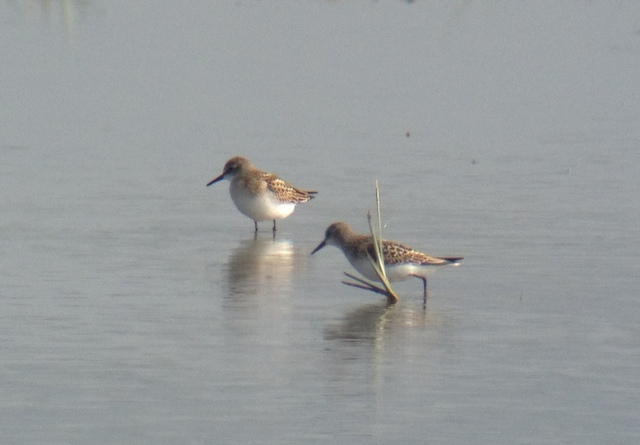 Little Stint – we found two in with the Dunlin flock this morning
Little Stint – we found two in with the Dunlin flock this morning
In contrast, the Knot were noticeably larger than the Dunlin. There was no hiding the bright, summer plumage adult, sporting bright orange underparts, but the peachy-breasted juvenile was more subtle. As well as size, the Knot were more rotund and shorter-billed, and lacked the dark belly markings of the Dunlin. On the open mud on the islands nearby, several Ringed Plovers were running around as well.
Out in the far corner of the scrape, we picked up a single Green Sandpiper feeding amongst the vegetation. Thankfully it flew round calling and landed much closer to us, where we could a better look at it through the scope, before it made its way back into one of the more secluded areas, out of view. A large flock of Lapwing flew in and landed on Pat’s Pool and we could hear Golden Plover calling as well as they arrived though couldn’t pick any out looking into the sun at the massed ranks. A single Sandwich Tern was hiding amongst the roosting Black-headed Gulls, from where we could get a great view of the distinctive yellow tip to its black bill.
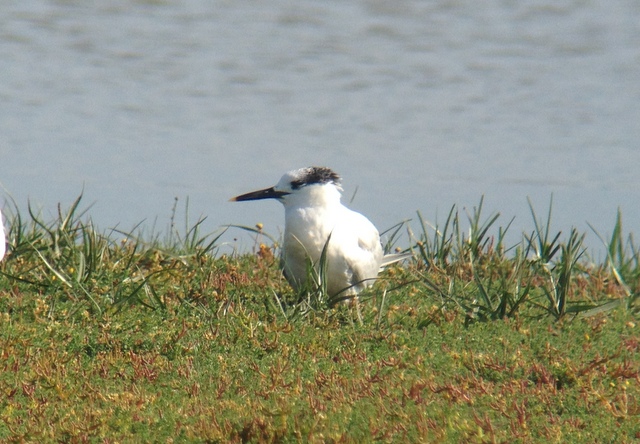 Sandwich Tern – with a yellow-tipped black bill
Sandwich Tern – with a yellow-tipped black bill
One of the other people in the hide thought they had seen a Hobby distantly over the shingle ridge and suddenly not one but two Hobbys powered in towards us from the direction of North Scrape. The birds we had been watching on the scrapes all scattered, particularly the Dunlin flock which whirled round over the water in panic. One of the Hobbys stooped at the flock and in the resulting chaos one of the waders got separated from the group. The two Hobbys then proceeded to take turns stooping at it – unfortunately chasing it round behind the hide where we couldn’t see its fate. Stunning to watch.
As the waders all scattered, we could hear a Wood Sandpiper calling and managed to pick up two distantly, flying off over the Eye Field with a flock of Dunlin. There was very little left on Simmond’s Scrape after that, so we decided to have a look at North Scrape instead. As we walked along the beach, we could see a few distant Gannets passing by offshore.
The Hobbys had also done a good job at clearing out North Scrape of waders, and there were only a handful of Dunlin left, amongst the hordes of ducks. We did see our first Curlew of the day, preening out on one of the islands. And, as we sat and watched for a while, a Greenshank appeared feeding very actively around the edge of the scrape.
Just as things were settling down, a Sparrowhawk flew over. It was chased off by a Little Ringed Plover which came up from the pool behind us by the beach, heading away over Billy’s Wash. As it did so, it flushed a couple of Common Snipe, Green Sandpipers and Wood Sandpipers from where they had been lurking out of sight, though they quickly dropped down again amongst the tall grass.
Once the Sparrowhawk had disappeared, the Little Ringed Plover dropped back down onto a shingle island in the pool. As we walked round to get a better look at it, we could see why. A second Little Ringed Plover appeared from the vegetation, this one a scaly backed juvenile, not fully grown and still with fluffy juvenile down on its head. We got a good look at both of them in the scope, particularly noting the bright golden-yellow eye-ring of the adult. While we were watching them, we heard a Common Sandpiper calling and it appeared from over the Eye Field and dropped down onto the island beside them. It stood bobbing its tail for a second, before disappearing round the back out of view.
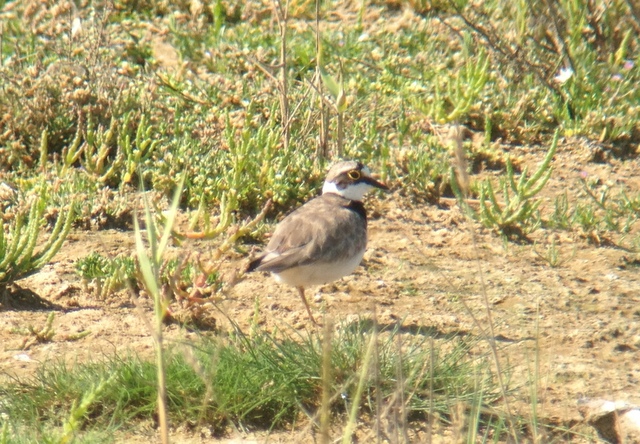 Little Ringed Plover – an adult with bright yellow eye-ring
Little Ringed Plover – an adult with bright yellow eye-ring
We had done really well for waders at Cley this morning, but there were a couple of key target species missing. We decided to head along to Titchwell for the afternoon, to see what else we could add.
On the walk out, we stopped to have a look at the reedbed pool. A single female Red-crested Pochard was out on the water,along with a selection of commoner ducks. A well-grown, stripy-headed juvenile Great Crested Grebe swam out into the middle but an adult Little Grebe stayed close to the reed edge with its smaller youngster. We could hear Bearded Tits calling, but they did not show themselves today – perhaps it was just a touch too breezy.
 Avocet – needless to say, there were plenty still at Titchwell today
Avocet – needless to say, there were plenty still at Titchwell today
The water level on the freshmarsh is still higher than it has been in recent weeks, and there were fewer small waders as a result. From Island Hide, we could see that there were still a few Dunlin, mostly juveniles, lurking around the edges of the islands or the remaining strips of mud over by the edge of the reeds. However, we did see our third Little Stint of the day, over on the islands by the main path – we would have a closer look at that later!
Out in the middle of the freshmarsh was a large flock of roosting waders. Through the scope we could see that they were mostly Bar-tailed Godwits, sleeping out the high tide on the beach. Also asleep amongst the islands, we located one of the wader species we had hoped to see – a small group of 8 Spotted Redshanks. They were mostly asleep, but a couple woke up and had a quick preen, letting us see the long and needle-fine bill, with a small downward kink just at the very tip. They were all mostly in silvery grey and sparkling white winter plumage but a ninth Spotted Redshank joined them, this one still in partial summer plumage with extensive white splotches on its formerly black underparts.
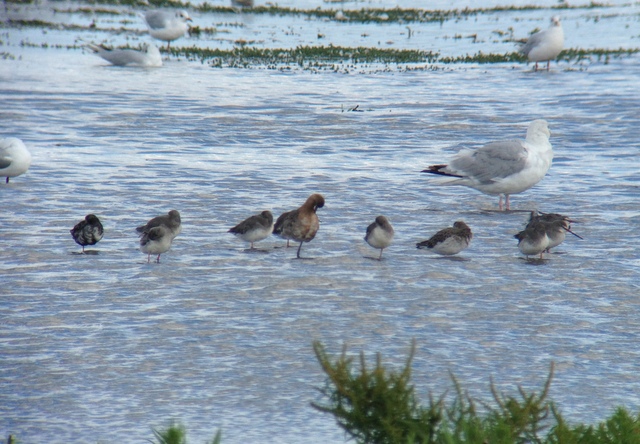 Spotted Redshanks – nine, one still in partial black summer plumage
Spotted Redshanks – nine, one still in partial black summer plumage
Over on the edge of the reeds, a Green Sandpiper was feeding in and out of the vegetation. It stopped for a while to preen and we got a great look at it in the scope. A Common Sandpiper appeared next to it – much smaller, paler and greyer-brown above, and with the distinctive white spur between the breast and folded wing. A great side-by-side comparison.
 Green Sandpiper – preening by the edge of the reeds
Green Sandpiper – preening by the edge of the reeds
There is no exposed mud in front of Island Hide at the moment, so fewer waders close in. However, those that do come in can be very close indeed. Today we were graced with excellent frame-filling views of a couple of adult Ruff….
 Ruff – an adult, right outside Island Hide
Ruff – an adult, right outside Island Hide
… and Lapwing.
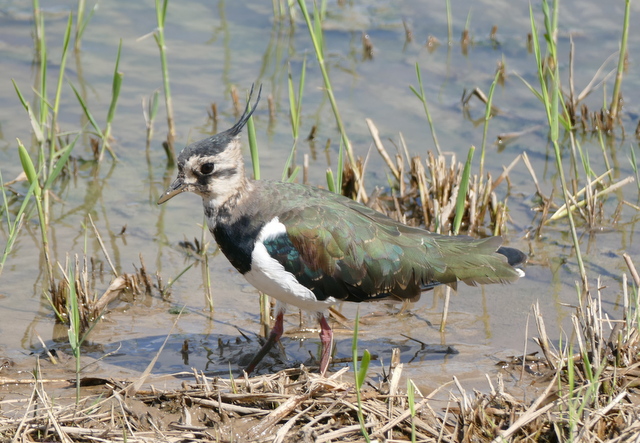 Lapwing – also right in front of Island Hide
Lapwing – also right in front of Island Hide
There were also lots of gulls roosting on the freshmarsh. Lots of Lesser Black-backed Gulls and Black-headed Gulls, plus several Herring Gulls and a handful of Common Gulls. In amongst them, a single bird with a mantle intermediate in grey shade between the Herring and Lesser Black-backed Gulls, and sporting yellow legs, was an adult Yellow-legged Gull. There were also a few Common Terns, as usual.
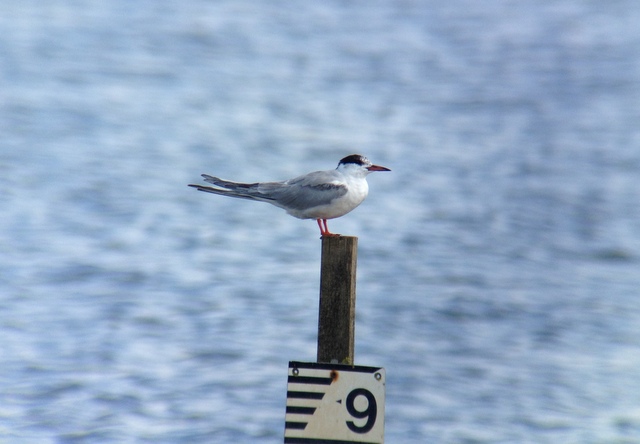 Common Tern – checking the water level on the freshmarsh
Common Tern – checking the water level on the freshmarsh
We decided to head round to Parrinder Hide to see if we could add anything else to the day’s list. From up on the bank, we could see the Little Stint still out on the islands. We stopped to watch it and it flew even closer, onto the nearest island and feeding feverishly, it worked its way right round in front of us giving us great views.
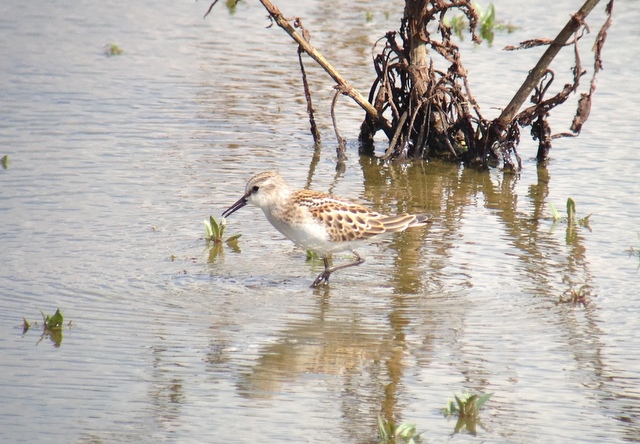 Little Stint – great views on the edge of the freshmarsh this afternoon
Little Stint – great views on the edge of the freshmarsh this afternoon
While we were watching the Little Stint, we picked up a Hobby approaching from further out towards the sea. It came leisurely towards us until it got over the path to Parrinder Hide, when it suddenly turned and dropped into a steep dive towards the freshmarsh. For some reason, rather than targeting something small and bite-sized like a Dunlin, it made straight for an unsuspecting Lapwing. Both birds seemed to get a bit of a shock – the Lapwing realised its impending fate at the last minute and leapt up with wings open, whereupon the size of its target presumably dawned on the Hobby and it veered away sharply. The moment of surprise was squandered and it drifted off towards the reedbed.
It was worth the walk round to Parrinder Hide today. A Common Snipe stood preening on the water’s edge in front before disappearing back into the vegetation. We finally got proper views of a Wood Sandpiper for the day, on one of islands over by the bank, at one point joined by two more Common Sandpipers. Two Yellow Wagtails were flitting round with the Pied Wagtails.
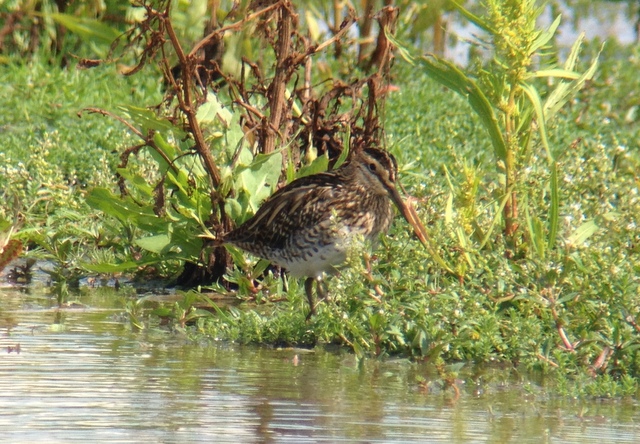 Common Snipe – hiding in the vegetation from Parrinder Hide
Common Snipe – hiding in the vegetation from Parrinder Hide
Out on the Volunteer Marsh, were several Grey Plovers. Most of them are still in stunning summer plumage, with black bellies and faces and bright white speckled upperparts.
 Grey Plover – particularly stunning birds in summer plumage
Grey Plover – particularly stunning birds in summer plumage
In front of the hide, we also had great views of a particularly obliging Curlew, which walked slowly past us, occasionally stopping to probe into the mud. While we were in the hide, a Marsh Harrier flew over – another passing raptor throwing the waders into a panic once again. A flock of Dunlin swirled round with the Little Stint now in amongst them for safety and landed out on Volunteer Marsh once the panic subsided.
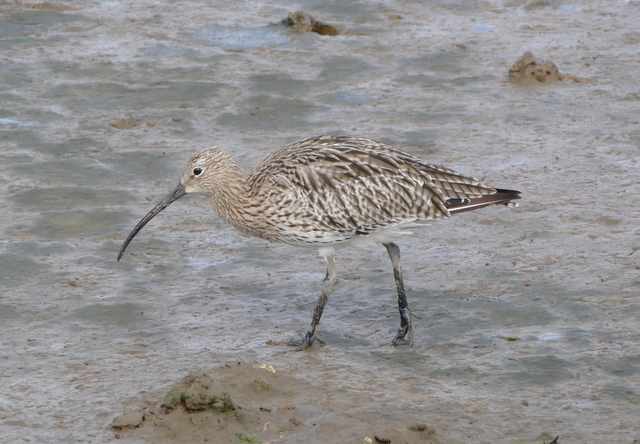 Curlew – this obliging individual posed in front of Parrinder Hide
Curlew – this obliging individual posed in front of Parrinder Hide
Out at the tidal pools, a careful scan revealed a bird hiding in the long grass. It was feeding and occasionally put its head up just long enough to confirm it was a Whimbrel, with pale central crown stripe between two dark lateral stripes, rather different from the plainer head of the Curlew behind. There were also more Black-tailed Godwits feeding out here today, a couple still in rusty summer plumage.
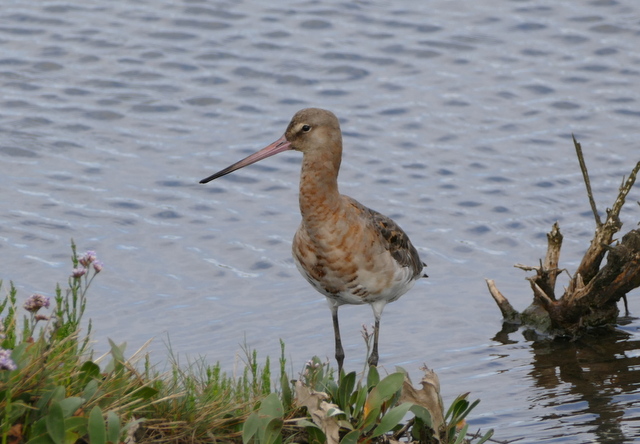 Black-tailed Godwit – another particularly obliging bird today
Black-tailed Godwit – another particularly obliging bird today
There were only a couple of other waders we could possibly see in North Norfolk today and we found both of them out on the beach. Several Turnstone were out on the rocks, mostly still in bright summer plumage. Further east, a couple of Sanderling were feeding out on the wet sand. There were also the usual Oystercatchers, Bar-tailed Godwits, Knot, Curlews and Redshanks out there today. A quick look at the sea to round things off produced a single Common Scoter and Great Crested Grebe.
Then it was time to head back, pausing to admire a Little Egret by the path on the way. It had been quite a day – with 24 species of wader to show for it, as well as much more besides.
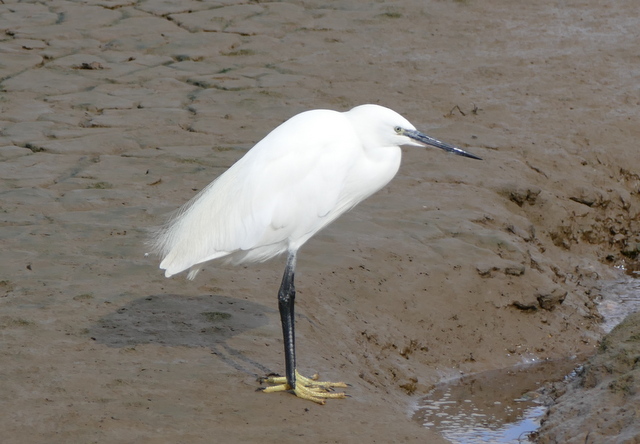 Little Egret – by the path on our way back; note the yellow feet
Little Egret – by the path on our way back; note the yellow feet
















